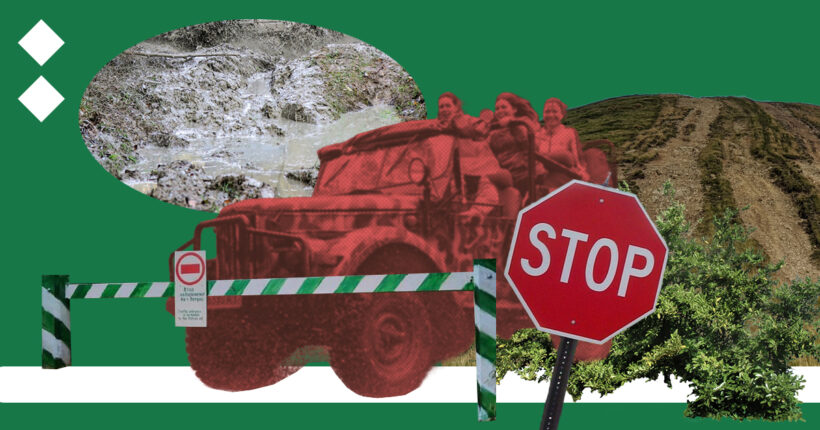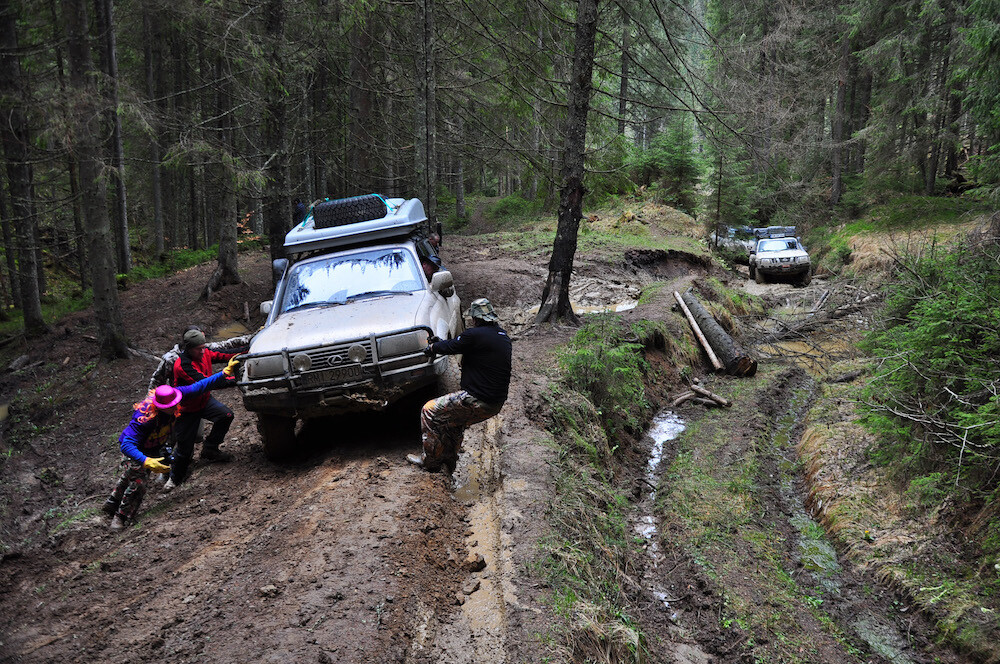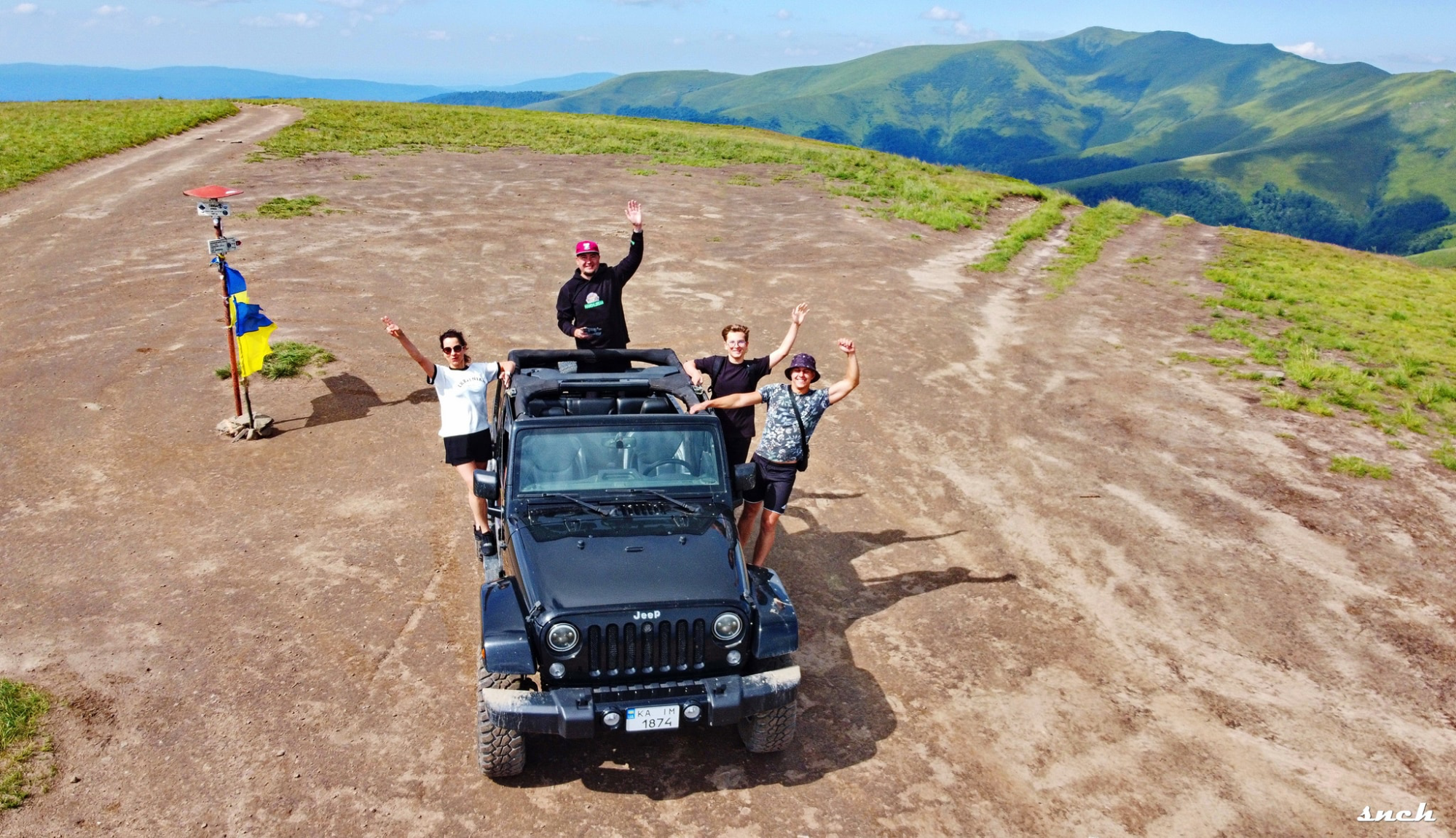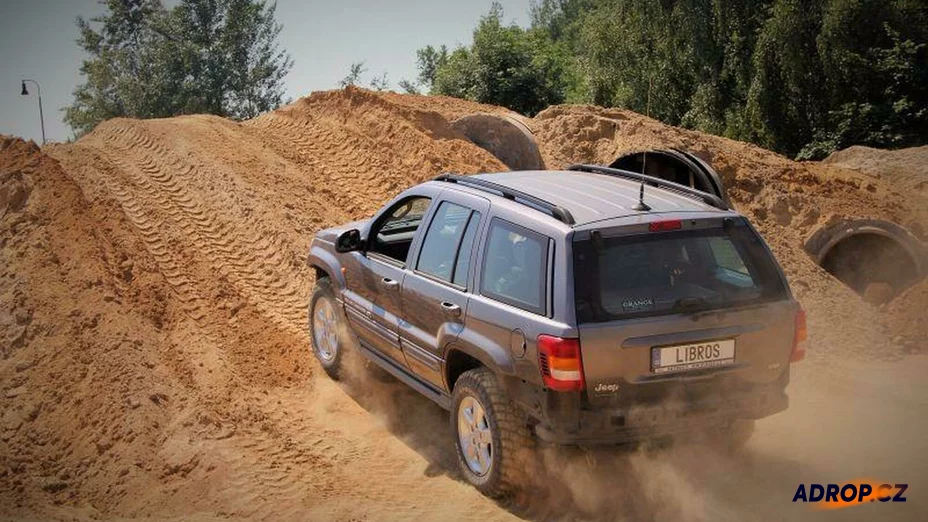
What is the problem?
Jeeping
The Carpathians are a popular vacation spot among Ukrainians. Entertainment options are diverse, and people who like relaxing, sports, or extreme recreation can easily find activities here.
But the heavy tourist traffic in the Carpathians does not always allow local ecosystems to recover in time. We take too much and give almost nothing back to nature to preserve itself. If people continue to use the Carpathians to the maximum, as they do now, they will lose their beauty with time.
Jeeping is one of the popular types of recreation in the Carpathians today. As a rule, this type of extreme recreation is trip of several hours on an off-road vehicle on mountain routes that pass through roads, tourist trails, rivers, and forests. At the same time, the more wild the route, the more interesting it can be for tourists seeking an exciting escape.
In almost all tourist locations, ads for renting an SUV are ubiquitous. The Carpathian Mountains offer jeeping in Yaremche, Mykulychyn, Bukovel, Vorokhta, and Verkhovyna — wherever willing tourists appear. Polonyna Borzhava, Svidovets Ridge, and Pip Ivan Mountain are the most popular locations for jeepers.
Some travel companies take those willing to conquer the mountains on wheels from Ivano-Frankivsk, which can be a problem.
Every time, it gets worse: "You will not think about blueberries in the mountains because you will be sick from the unbearable smell of rotting in puddles"

Consequences of jeeping in the Carpathians. Photo: przygody4x4
Pavlo Skirko, an experienced tourist who goes to the Carpathians several times a year to take another exciting route or take part in tourist competitions, tells Rubryka: "Imagine what it's like to climb a mountain where there have never been cars: you walk along a narrow stony path surrounded by grass and blueberry bushes. You climb a trail that has looked like this for hundreds of years."
The first jeep driver who conquers this peak will only dent the bushes and leave tracks that look like new trails — and perhaps decide that they have done nothing wrong. The second will see the already existing tracks and decide that it is possible to drive here. The third will drive in the rain and turn these tracks into deep ditches with mud.
"The next time you walk here, you won't recognize this place — in the place of the old path, there will be a disgusting, stinking swamp. On steep slopes where water cannot accumulate, you will see slippery clay that is impossible to walk on. The tracks of the jeeps will be all over the slope because each subsequent 'conqueror' will look for an area with still-living grass to gain traction on the road. There will be almost no blueberries left, but you will not think about them because you will be sick of the unbearable smell of rotting in the puddles that collect at the bottom of the car tracks and of regret for the lost beauty of your favorite slopes," says Pavlo about his impressions of jeeping.
He personally saw all these consequences of the wheeled conquest of the Carpathian peaks.
As a tourist, he believes that jeeping is harmful, primarily because small groups of people seeking short-term pleasure often destroy the common mountain space for the majority.
"I do not believe I have more right to the Carpathian trails than anyone else, so I always strive to leave the mountains as they were, or better. Jeepers leave the mountains unrecognizable," Skirko insists.
What does it mean in the language of ecologists?
The phenomenon described by Skirko is soil erosion caused by the passage of cars in the mountains. Its effects are particularly visible on Svydovka and Borzhava, where you can see four to five or more tracks in a row.
Ecologist Timur Berednichek explains that the higher you go in the mountains, the more noticeable the negative impact of jeeping and other anthropogenic factors because alluvial forests grow much slower than floodplain forests. Mountain-meadow and meadow-brown earth soils, characteristic of subalpine and alpine meadows, are formed many times more slowly than brown soils in a beech forest.
Driving a jeep along a mountain river is bad, but driving through high-altitude lakes on Svydovka is much worse because it can take the soil at altitude hundreds of years to regenerate. The red rue, white dream, mountain geranium, cypress, and other flowers listed in the Red Book no longer bloom where the jeeps pass.
Another negative factor of jeeping is the disturbance factor. Jeepers regularly hold their competitions in the quiet season, in violation the law.
After all, off-road vehicles for entertainment are old, bought cheaply, and used in the mountains until they are ruined. Jeepers may even find a certain exoticism in this, but such cars lead to terrible pollution. Leaking oil and antifreeze lead to air, water, and soil pollution, and animals and plants unfortunate enough to be under the wheel die.
Current legislation prohibits jeeping, but it is not enforced
In regulated recreation areas and in the territory of natural and biosphere reserves, protected areas, and natural tracts, the law allows the movement of motor vehicles only on public roads. The list of these roads is updated every three years and can be found here. Roads on mountain ranges and forest roads that lead from one place to another are not public.
However, on the territory of national nature parks, it is expressly prohibited to use cars, even on roads, as well as to hold competitions, races, rallies, and trophy raids with the use of mechanized transport activities and motor boats.
Violations of these norms are subject to fines established by the administration of the protected natural zone. However, it does not always happen. Some jeepers do not even know they are breaking the law and post photos of their jeeps from the picks on social media — from those places where it is forbidden to drive cars at all.

Photo from Oleksandr Malyon's Facebook page. "At the top of Gemba," Malyon signed his post, not knowing that the top of Gimba, or Gemba, is the top of the Polonyna Borzhava mountain massif, which is entirely a protected tract. Behind the tourists are three roads that should not be on the top at all.
What is the solution?
Look for alternatives
In fact, jeeping exists not only in Ukraine but jeeping in national parks seems to be a truly "unique pastime." However, it would be difficult to ban jeeps in the Carpathians at all, and SUVs are still needed in the mountains.
For example, you can get to the highest mountain resort in Ukraine, Dragobrat, only by SUV — as a rule, locals use old GAZs or UAZs to deliver goods.
Therefore, to reduce the anthropogenic load on the Carpathians, it is necessary to develop a replacement for environmentally harmful entertainment for those who like to conquer dangerous and difficult roads on jeeps.
"I have no idea how jeeping could exist in the Carpathians without destroying them for everyone. If you want to test your car off-road, look for a specialized track for that," advises Skirko.
By contrast, in the Czech Republic, 4×4 lovers are offered vivid impressions on military training grounds. The tracks have different types of surfaces with difficult sections — sandy, swampy, or rocky, so tourists can practice extreme driving skills more safely than in the mountains.

Jeeping in the Czech Republic at a military ground. The photo is illustrative. Source: Adrop.
In Germany, off-road lovers are offered trips on off-road vehicles between cities — this is a tour of several days, during which the participants stay overnight in campsites. The tour itself is laid out on ordinary long-distance roads, mostly unpaved.
One of the German companies offers off-road tours all over Europe, in some places through national parks. Still, after looking at the video card of a trip through a national park in Montenegro, it is clear that they drive there only on dirt or asphalt roads intended for cars.
How to fight jeepers?
Let's imagine a situation in which you are a tourist with a backpack on your shoulders, traveling along amazing and picturesque Carpathian roads. And here, the sound of the wind in the trees and the distant roar of the river interrupts the sound of the engine, which is gradually approaching, and you already understand that for the next few minutes, you will be coughing from dust and wiping the sand from your sweat-soaked skin.
Whether you know or don't know if the area has a special status — a regulated recreation area, a natural or biosphere reserve, a protected area or natural tract, or a national park — pick up the phone as soon as possible. Every car should a license plate, which makes it easy to identify the owner.
- Take photos of the car with geolocation. Make sure the license plate is clearly visible.
- When you return to civilization, send a photo with a link to the location where you saw the offending vehicle to the police.
You can find out about the location of protected areas, including protected tracts, on this map.
What will happen in the future?
The Ministry of Environment is initiating a ban on jeeping in protected areas and has already developed a corresponding draft law. This became known on October 6, when the ministry reported the news.
"Moving on jeeps, enduro motorcycles, quad bikes, and buggies causes significant environmental damage. To stop the destruction of the environment in this way, the Ministry of Environment has developed a draft law that amends the Law of Ukraine 'On the Nature Reserve Fund of Ukraine' and the Code of Ukraine on Administrative Offenses," the message reads.
The draft document prohibits the passage of cars on the territories of nature reserve fund — not only in national parks, zones of regulated recreation, the territory of natural and biosphere reserves, protected areas, and natural tracts, as it is provided now, but also in all other types of nature reserves.
The new regulations aim to enforce a ban on vehicles in :
- regional landscape parks
- reserves
- sights of nature
- botanical gardens
- zoological parks
- dendrological parks and parks-monuments of horticultural art.
At the same time, the ministry noted that the ban will not apply to public roads, streets, and roads of cities and other settlements, as well as highways in private territories. The Ministry of Environment indicated that this would help protect biodiversity from destruction and chemical pollution, noise, and vibrations caused by cars.
The draft law was discussed and supported by representatives of non-governmental organizations, such as Kyiv ecological and cultural center, WWF-Ukraine, NGO Living Planet, Ukrainian Society for the Protection of Birds, Environment People Law (EPL), Chysto.de, Ukrainian Nature Conservation Group — UNCG, and others.
Newsletter
Digest of the most interesting news: just about the main thing







